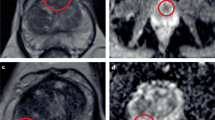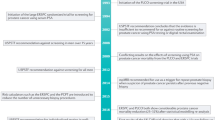Abstract
Active surveillance is a new strategy that aims to individualise therapy by selecting only those men with significant cancers for curative therapy based on early evidence of disease progression. Active surveillance must be distinguished from watchful waiting, which for decades has described a policy of observation with the use of palliative treatment for symptomatic progression. The rationale for active surveillance is discussed, based on our knowledge of the natural history of PSA-detected early prostate cancer. The initial results of active surveillance have demonstrated its feasibility. Ongoing studies seek to optimise the active surveillance protocol, and to determine the long-term outcomes. Looking ahead, dietary intervention in men on active surveillance could become an important new paradigm for prostate cancer management.
This is a preview of subscription content, access via your institution
Access options
Subscribe to this journal
Receive 4 print issues and online access
$259.00 per year
only $64.75 per issue
Buy this article
- Purchase on Springer Link
- Instant access to full article PDF
Prices may be subject to local taxes which are calculated during checkout


Similar content being viewed by others
References
Albertsen PC, Hanley JA, Gleason DF, Barry MJ . Competing risk analysis of men aged 55 to 74 years at diagnosis managed conservatively for clinically localized prostate cancer. JAMA 1998; 280: 975–980.
Chodak GW et al. Results of conservative management of clinically localized prostate cancer. N Engl J Med 1994; 330: 242–248.
Johansson JE et al. Fifteen-Year survival in prostate cancer. A prospective, population- based study in Sweden. JAMA 1997; 277: 467–471.
Draisma G et al. Lead times and overdetection due to prostate-specific antigen screening: estimates from the European Randomized Study of Screening for Prostate Cancer. J Natl Cancer Inst 2003; 95: 868–878.
Etzioni R et al. Overdiagnosis due to prostate-specific antigen screening: lessons from U.S. prostate cancer incidence trends. J Natl Cancer Inst 2002; 94: 981–990.
McGregor M, Hanley JA, Boivin JF, McLean RG . Screening for prostate cancer: estimating the magnitude of overdetection. Can Med Assoc J 1998; 159: 1368–1372.
Nicholson PW, Harland SJ . Survival prospects after screen-detection of prostate cancer. BJU Int 2002; 90: 686–693.
Steineck G et al. Quality of life after radical prostatectomy or watchful waiting. N Engl J Med 2002; 347: 790–796.
Stamey TA et al. Prostate specific antigen in the diagnosis and treatment of adenocarcinoma of the prostate. II. Radical prostatectomy treated patients. J Urol 1989; 141: 1076–1083.
Schmid HP, McNeal JE, Stamey TA . Clinical observations on the doubling time of prostate cancer. Eur Urol 1993; 23 (Suppl 2): 60–63.
Parker CC, Dearnaley DP . The management of PSA failure after radical radiotherapy for localized prostate cancer. Radiother Oncol 1998; 49: 103–110.
Sandier HM et al. Overall survival after prostate-specific-antigen-detected recurrence following conformal radiation therapy. Int J Radial Oncol Biol Phys 2000; 48: 629–633.
McLaren DB, McKenzie M, Duncan G, Pickles T . Watchful waiting or watchful progression?: prostate specific antigen doubling times and clinical behavior in patients with early untreated prostate carcinoma. Cancer 1998; 82: 342–348.
Choo R et al. PSA doubling time of prostate carcinoma managed with watchful observation alone. Int J Radiat Oncol Biol Phys 2001; 50: 615–620.
Choo R et al. Feasibility study: watchful waiting for localized low to intermediate grade prostate carcinoma with selective delayed intervention based on prostate specific antigen, histological and/or clinical progression. J Urol 2002; 167: 1664–1669.
Carter HB, Walsh PC, Landis P et al. Expectant management of nonpalpable prostate cancer with curative intent: preliminary results. J Urol 2002; 167: 1231–1234.
Epstein JI, Walsh PC, Carter HB . Dedifferentiation of prostate cancer grade with time in men followed expectantly for stage T1c disease. J Urol 2001; 166: 1688–1691.
Choo R, Do V, Sugar L et al. Comparison of histologic grade between initial and follow-up biopsy in untreated, low to intermediate grade, localized prostate cancer. Can J Urol 2004; 11: 2118–2222.
Donovan et al. Prostate testing for cancer and treatment (ProtecT) feasibility study. Health Technol Assess 2003; 7: 1–88.
Author information
Authors and Affiliations
Corresponding author
Rights and permissions
About this article
Cite this article
Parker, C. Active surveillance of early prostate cancer: rationale, initial results and future developments. Prostate Cancer Prostatic Dis 7, 184–187 (2004). https://doi.org/10.1038/sj.pcan.4500720
Received:
Revised:
Accepted:
Published:
Issue Date:
DOI: https://doi.org/10.1038/sj.pcan.4500720
Keywords
This article is cited by
-
Dynamic optimal strategy for monitoring disease recurrence
Science China Mathematics (2012)
-
Serum micronutrient and antioxidant levels at baseline and the natural history of men with localised prostate cancer on active surveillance
Tumor Biology (2010)
-
Strategien zur Behandlung des lokal begrenzten Prostatakarzinoms
best practice onkologie (2008)
-
Patient satisfaction with nurse-led telephone consultation for the follow-up of patients with prostate cancer
Prostate Cancer and Prostatic Diseases (2007)
-
A model of the natural history of screen-detected prostate cancer
British Journal of Cancer (2006)



